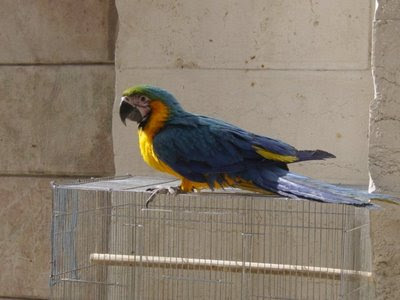 |
| click to enlarge |
Source: This print from a Dergé woodblock carving represents the Zhijé and Cutting lineages. Both together constitute one of the Eight Chariots of Kongtrul (each of the Eight Chariots has its own Dergé woodblock, forming a set). This was seen long ago on the internet, but is no longer there. Well, wait, I spoke too soon, try this link. For an especially crisp image, go here first and then scroll down to find it. Himalayan Art Resources does have a print (item no. 87609). It seems rather faint and difficult to see, but if you use the magnifier, you can even read the labels for the two divine protectors of the lower corners: Gönpo Aghora and Zangri Tsangöd (མགོན་པོ་ཨ་གྷོ་ར་ & ཟངས་རི་བཙན་རྒོད་).
1 2 3
4 5 6 7 8
10 9 11
12 13
14 15
16 17
18 19 / 20
21 22 24 23
25 26
27 28
Top inscription: sgrub brgyud shing rta / g.yon dang po / dam pa rgya gar dang ma gcig lab sgron [illeg.]
Roughly translated: This is the first thangka on the left in the set of the eight Accomplishment Transmission chariots. This one features Dampa Sangyé and Machik Labdrön.
1. ’Jam-dpal Smra-seng (Smra-ba’i Seng-ge, Lion of Speech, or Mañjuśrî).
2. Unmarked Buddha figure (appears to be Prajñāpāramitā).
3. Spyan-ras-gzigs (Avalokiteśvara).
4. Grub-chen Mtsho-skyes (Great Siddha Saroruha). He serves here to represent Padampa’s many teachers, both men and women, in India.
5. Mkhan-po Dge-ba’i-lha (Padampa’s monastic ordinator, his mkhan-po. The name has been restored into Sanskrit as *Kṣemadeva).
6. A Buddha, unmarked, right hand in earth touching gesture.
7. Gser-gling-pa (Suvarṇadvīpa).
8. Bram-ze Ārya-de-wa (Padampa’s maternal uncle, Brahmin Āryadeva).
9. PHA-DAM-PA (the larger main figure, unmarked). Notice that here Padampa is depicted with a Cutting implement, the ḍamaru (ཅང་ཏེའུ་), and not in one of his Zhijé forms.
10. Kha-che Dznyā-na-guhya (Kashmiri Jñānaguhya).
11. Gra Mngon Dbang-phyug-’bar (i.e., Grwa-pa Mngon-shes-can).
12. Skyo-ston Bsod-nams-bla-ma.
13. Yar-klung Sma-ra Ser-po.
14. Rma Chos-kyi-shes-rab.
15. So Dge-’dun-’bar.
16. LHO [SOUTH GATE] Badzra-kro-dha.
17. NUB [WEST GATE] Phyar-chung.
18. Kaṃ Ye-shes-rgyal-mtshan (Skam Ye-shes-rgyal-mtshan).
19. BYANG [NORTH GATE] Dam-pa Kun-dga’.
20. Pa-tshab Sgom-pa.
21. SHAR SGO [EAST GATE] Dam-pa Phyar-chen.
22. Rgyal-ba Te-ne (=Rgyal-ba Rten-ne).
23. Rog Shes-rab-’od.
24. MA-GCIG LAB-SGRON.
25. Sras Rgyal-ba-don-grub. (This with the following three ought to be the ‘four great sons’ of Ma-gcig, although the inscriptions are hard to make out in the scan.)
26. Khu-sgom Chos-seng.
27. Thod-smyon Bsam-’grub (The inscription isn't visible, so I follow the version in the Molk book, p. 100).
28. Dol-ba Zang-thal (the spellings Dol-pa Bzang-tha and Dol-pa Zang-thal occur elsewhere).
My notes
Number 10 is Padampa’s main disciple of the Early Transmission. This transmission occurred in India prior to Padampa’s first sojourn in Tibet.
Numbers 11, 14, 15 and 18 represent only some of Padampa's lineage disciples from his Middle Sojourn in Tibet (i.e., the Middle Transmission). Their meetings with Padampa would have occurred in vicinity of 1050 C.E.
Numbers 16, 17, and 19 to 23 are disciples of Padampa, and disciples of his disciples, all belonging to the Later Transmission.
Numbers 24-28 are Macig Labdrön and her disciples, although nos. 12 and 13 also belong to her Cutting lineage.
 |
| Closeup of nos. 19 & 20 |
One last word
The nos. 16, 17 19 & 21 form a set of Padampa’s four chief or “Gateway” disciples in the Later Transmission. Each of them at one time had a set of Padampa teachings associated with his name, although Kunga’s (no. 19) was the longest and almost all of the writings we have today result from his transcriptions in Tingri, although Kunga's disciple Patsab (no. 20) also played a role in organizing Kunga’s notes, writing commentaries and so on. Notice that Kunga and Patsab are the only ones depicted directly interacting with each other. Kunga holds what appears to be a treasure box, with a tiny book — it could be a reliquary box — tied up in his topknot, while Patsab is in front of him offering him a book. I believe these details reveal the artist’s consciousness of their importance in ensuring a future for Zhijé books preserving Padampa’s words. We do need to thank them, particularly today.
§ § §
References
Jamgön Kongtrul Lodrö Taye, compiler, Zhije, the Pacification of Suffering, from The Treasury of Precious Instructions: Essential Teachings of the Eight Practice Lineages of Tibet Volume 15, translated by Sarah Harding, Snow Lion (Boulder 2019). The paper cover of the hardbound volume, as you can see above, displays a painted version of the Dergé woodblock print. You may find inside the book information that this painting was published courtesy of Sotheby’s 2017. I couldn’t locate it on Sotheby’s website. Still, other painted versions can be seen elsewhere on the web, at the Tsadra site for example, and at a few commercial sites that I cannot link here due to my noncommercial policy. Paintings that pattern themselves after woodblock prints can appear quite differently, with varying degrees of artistry, and of course different colorations.
David Molk with Lama Tsering Wangdu Rinpoche, translators, Lion of Siddhas: The Life and Teachings of Padampa Sangye, Snow Lion (Ithaca 2008). At p. 100 is a different print of the same Dergé woodblock print, although it appears to me as if some retracing has been done. In some places it is clearer. Still, the labels are only possible for me to make out with difficulty even with a magnifying glass. It could be because my reading glasses have suddenly gone up to 3.5’s.
- I think some may find it interesting and instructive to compare this Dergé print with a much older thangka painting that also has Padampa as its main subject, something we looked into in a 2011 Tibeto-logic blog, “A Padampa Portrait Painting: The Middle.”





















